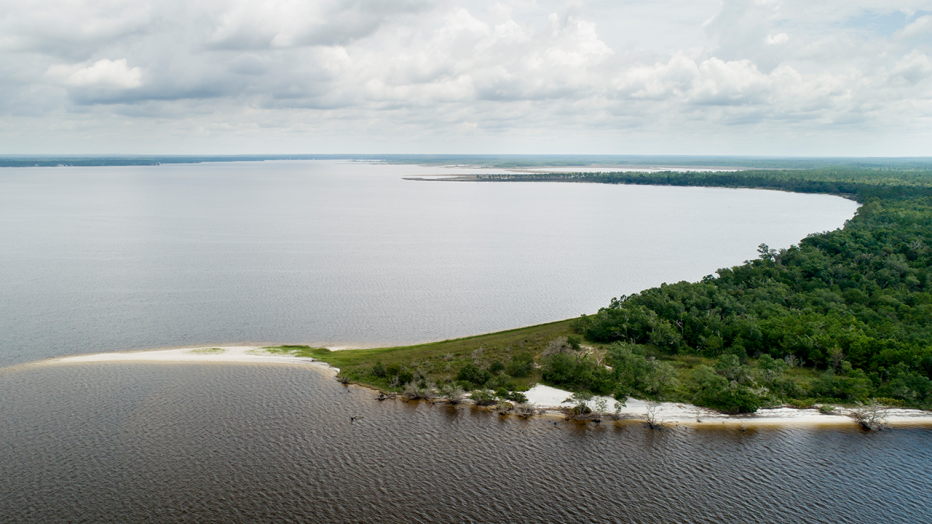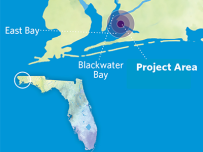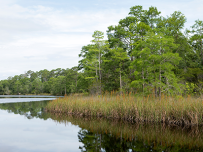
In 2016, The Nature Conservancy (TNC) selected Jacobs to manage the monitoring, permitting and design of a restoration project, the Pensacola East Bay Oyster Habitat Restoration Project, along a 6.5 mile stretch of shoreline, which will help restore a healthy, functioning oyster habitat in East Bay near Pensacola, Florida. This program is a multi-year effort to restore this critical estuarine habitat that has been significantly reduced from its former range across the Gulf’s bays and estuaries. TNC selected Jacobs for this project because of its in-house ecology, modeling, coastal engineering and design experience on oyster habitats and living shoreline projects, combined with its local homegrown knowledge of the Gulf of Mexico.

A recent milestone on the project was reached when construction workers started to place 33 oyster reefs along the Santa Rosa County shoreline. The reefs will benefit the oyster fishery, wildlife, water quality and nearshore habitats. The project aligns with the Oyster Fisheries and Habitat Management Plan, which was developed by local stakeholders in partnership with TNC, to improve the resilience and sustainability of the oysters in the Pensacola Bay System. Implementation of the oyster management plan will be led by the Pensacola and Perdido Bays Estuary Program.
The restoration project is funded by a $15 million grant from the National Fish and Wildlife Foundation’s Gulf Environmental Benefit Fund (GEBF) through funding from the settlement of the Deepwater Horizon oil spill.
Oyster reefs are considered one of the planet’s most imperiled marine habitats. Over the past two centuries, more than 85 percent of the world’s oyster reefs have been lost. This statistic rings true in most of Florida’s bays and estuaries, including Pensacola. Oyster reefs face a variety of threats, including overharvesting, disease, pollution, and damage from boat traffic. TNC is working to restore these critical ecosystems in Florida and around the world.
“Oysters play a vital and often overlooked role in the health of our estuaries, our fisheries and our economy. Reinvigorating and conserving the oyster population in Pensacola Bay helps restore a vital part of the region’s rich history and puts to good use funds from the Deepwater Horizon Oil Spill that impacted the region so profoundly,” said Temperince Morgan, executive director of The Nature Conservancy in Florida.
© Devin Ford

Jacobs has designed the reef structures to maximize oyster settlement and success under specific local conditions, enabled by collecting and reviewing data from over two years of pre-construction monitoring and an intensive design and engineering process. The reefs will be constructed of limestone rock of select sizes and oyster shell. They will be placed between 200-500 feet off the east shores of East and Blackwater Bays in about 4 feet of water and may be visible at low tides during certain times of the year.
Once completed, the reefs will offer a place for oysters to settle, grow and contribute to the ecosystem by filtering water and providing an important habitat for commercially and recreationally valuable finfish, crabs, shrimp and birds. These reefs may also serve as a source of oyster larvae for the adjacent harvestable reefs restored by the state. Monitoring will continue for up to five years following the completion of construction.
"Oysters are unique in the marine world in that they are a species that forms a habitat that other species rely on—and they are a fishery,” said Anne Birch, marine program manager for The Nature Conservancy in Florida. “Oysters and the reef habitat they form are vital for the health and well-being of our environment, economies and communities throughout the Gulf of Mexico. As one of the indicators of the health of our estuaries, a decline in oysters is a signal to us to figure out why and intervene with actions to reverse the trend. Restoration of the habitat and addressing the root causes for their decline are critical steps toward their sustainable future.”
The oyster habitat restoration project reflects the long-term and collaborative effort of a diverse team of partners, including the oyster fishing community and a technical working group—a committee formed by TNC to provide feedback and expertise on the project design and monitoring. Participants include Eglin Air Force Base, Florida Department of Agriculture and Consumer Services Aquaculture Division, Florida Department of Environmental Protection, Florida Fish and Wildlife Conservation Commission (FWC), National Fish and Wildlife Foundation, National Oceanic and Atmospheric Administration, Santa Rosa County, Northwest Florida Water Management District and the U.S. Fish and Wildlife Service.
“Large scale restoration projects like the Pensacola East Bay Oyster Restoration project benefit from extensive partner coordination from the earliest phases of feasibility analyses to full implementation and monitoring,” said Kent Smith of the FWC. “The Nature Conservancy and their contractor Jacobs have established a model through the development and coordination of the Technical Advisory Group for this project that exemplifies partner coordination. Through this Technical Working Group, clear direction toward addressing concerns and project refinement toward mutual partner goals has been provided, and the final permit-ready designs meet partner expectations and avoid final processing conflicts.”
This restoration project, the largest Jacobs has designed, will not only restore oyster reefs in East Bay, but will provide shoreline protection, nursery and foraging habitat for other aquatic life. Reef restoration is also expected to complement the commercial oyster reefs and industry that have been hit hard over the years.
“By designing and constructing oyster reefs, we'll promote oyster settlement on the reef, provide for an additional aquatic habitat and reduce shoreline erosion,” said David Stejskal, Jacobs’ project manager. “The coast will see great restoration benefits such as enhanced fish and bird habitat and more sea grasses and protect the vulnerable shoreline.”
Stejskal and the Jacobs team have been provided planning, modeling, and design services for the previous phase of the project and will provide construction administration and observation through the construction period.
Jacobs was recently recognized for its leadership in nature-based coastal resilience solutions with an International Excellence Award from the Environment Agency for the Tyndall Air Force Base Coastal Resilience Study (skip to 37:39 for the Tyndall feature).














































